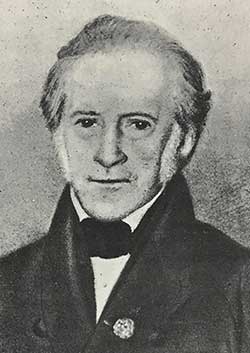
Council of Heads of Australasian Herbaria
Australian National Herbarium
Biographical Notes
 |
Council of Heads of Australasian Herbaria |
 Suttor, George (1774 - 1859)
Suttor, George (1774 - 1859)Born in Chelsea, London, England on 11 June 1774; died at Bathurst, NSW, on 5 May 1859.
He was the third son of a Scottish market gardener (and botanist on the estate of Charles Cadogan, 2nd Baron Cadogan) and his wife. Suttor, through contacts of his father, gained an interview with Sir Joseph Banks who sent Suttor to Australia with a collection of trees and plants including grapevines, apples, pears, and hops. These were put on board HMS Porpoise in October 1798, but delays took place and it was not until September 1799 that a proper start was made. A gale almost wrecked the ship, which was found to be unseaworthy, and a return was made to Spithead. In March 1800 another start was made on a corvette taken from the Spanish and renamed the HMS Porpoise and arrived in Sydney on 5 November 1800.
In spite of the delays, Suttor managed to land some of his trees and vines still alive. He was given a grant of land, and settled at Chelsea Farm, Baulkham Hills. In a few years time he was sending oranges and lemons to Sydney, obtaining good prices for them, and had become a successful settler.
At the time of the William Bligh rebellion in 1808, Suttor was a firm supporter of the deposed governor. Suttor was, however, arrested and sentenced to be imprisoned for six months for failing to attend Lieutenant-Governor Joseph Foveaux's general muster and for impugning his authority. The stand taken by Suttor was much to his honour; a full account of it will be found in the Historical Records of Australia, vol. VII, pp. 131–7.
In 1810 Suttor was summoned to England as a witness on behalf of Bligh, and arrived in Australia again in May 1812. In August 1814 Suttor was given the position of superintendent of the lunatic asylum at Castle Hill with a salary of £50; in February 1819 he was dismissed from this position on charges he used lunatic labour on his farm.
Suttor again took up land, and in 1822 he moved to beyond the Blue Mountains to the newly settled lands on the Bathurst plains. There he established the 130 hectares (320 acres) 'Brucedale Station' at the junction of Winburndale and Clear Creeks, which turned out to be a successful landholding leading to great prosperity, and by the 1830s it had been expanded to 4,055 hectares (10,020 acres). During a time of great conflict with the Indigenous Australians of the Wiradjuri nation, who resisted the taking of their lands, Suttor and his family (in particular son William) established good relations with the aborigines. They were known to have been close to the Wiradjuri's warrior leader Windradyne, and when Windradyne died he was buried at Brucedale.
After 1833 Suttor lived in Elizabeth Street, Sydney. In March 1839 he and his wife left for Europe in the Laura and toured the Continent, where Suttor obtained information on vineyards and wine-making. After his wife died at Rouen on 17 August 1844, Suttor embarked in the Thomas Lowry for Sydney. He arrived in November 1845 and in 1851 acquired Alloway Bank, Bathurst. On 5 May 1859 he died at Alloway Bank and was buried at Kelso, near Bathurst.
He collected for Joseph Banks around Sydney in the early 1800s, and published a paper on Australian forest trees in the Proc. Linn. Soc. London in 1843.
Source: Extracted from: https://en.wikipedia.org/wiki/George_Suttor
http://adb.anu.edu.au/biography/suttor-george-1270
Portrait Photo: Extracted from: Maiden, J.H. (1909) Sir Joseph Banks: The 'Father of Australia' Govt Printer, Sydney, p.211.